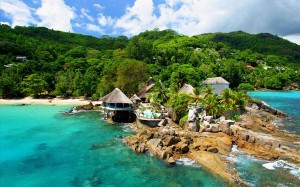Case-study /
Seychelles: Sea-Level Rise and Impacts in Africa, 2000 to 2100. Application of the DIVA model to Africa.


Mahe Island, Seychelles: Image: © zszywka.pl
Impacts of sea-level rise in Seychelles
The Seychelles consist of over 100 islands of granitic and coralline origin with a total land area of 455km2. Corel reefs surround the granitic islands. The coral islands are rich in marine life, and due to their size and homogeneity are considered part of the coastal zone. With a population of 87,000, 90% lives on Mahé, the main island (Times Books, 2008), where the coastal zone is under pressure from housing, industrial development, and intensive agricultural practices. Tourism and fishing are the main industries, with light manufacturing and service sectors also contributing to the economy. Tourism employs 40% of the work force and provides the population with 60% of foreign currencies (Lajoie, 2000). The country’s tourism industry and socio-economic development mainly depends on its environment, and hence any climate-related impacts could have a potential implication on the islands long-term prosperity and survival. Apart from tourism, sea-level rise will also impact the fishing industry. Ports and airports (built on reclaimed low ground) would also be severely affected. There would also be a serious ecological impact on coral islands (most of them being low-lying) by reducing light penetration (Lajoie, 2000), as the reef-building corals are dependent on light to survive and to maintain their biological functions. Reef ecosystems at the depth limit of coral growth would experience, as the sea level rises, diminished light conditions which will lead to their death. In addition, slow growing coral species would also contribute for the loss for being unable to keep the growing pace up with the rising sea level (Hoegh-Guldberg, 1999).
Rising sea levels also lead to greater erosion, and hence an increase in the number of landslides on the steep hill sides of the granitic islands would be expected. Furthermore, beaches would be inundated, ground water levels would rise threatening aquifers. The salinity of swamp areas would increase affecting plant growth (Lajoie, 2000).
Suggested citation
Brown, S., Kebede, A.S., and Nicholls, R.J. (2011). Sea-Level Rise and Impacts in Africa, 2000 to 2100. University of Southampton, UK, 215pp
